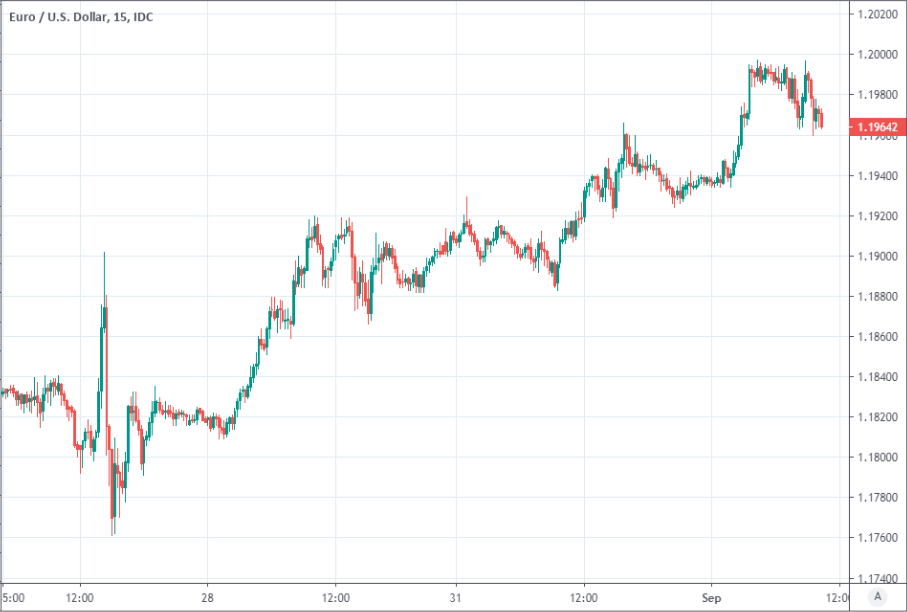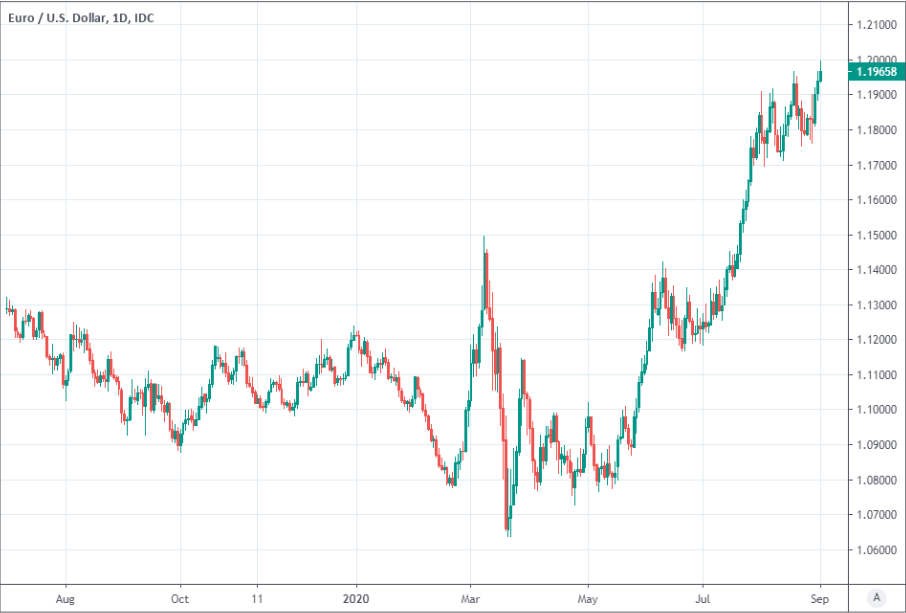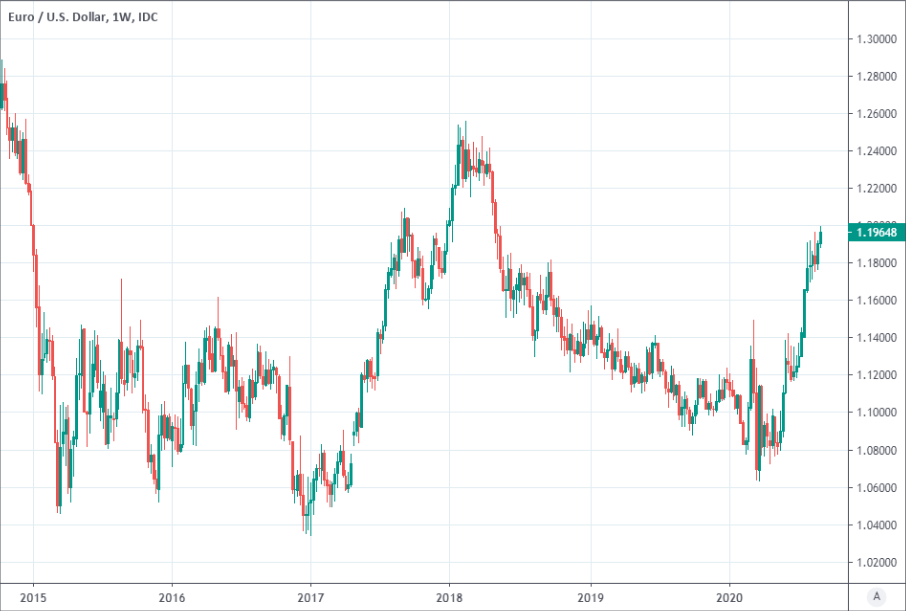Euro-Dollar Hits 1.20 Before Retreating on Shock Eurozone Deflation Data
- Written by: James Skinner, Additional Editing by Gary Howes

Image © Adobe Images
- EUR/USD spot rate at time of writing: 1.1960
- Bank transfer rate (indicative guide): 1.1553-1.1637
- FX specialist providers (indicative guide): 1.1792-1.1864
- More information on FX specialist rates here
The Euro-to-Dollar exchange rate rose to its highest level since April 2018 and the psychologically significant level of 1.20 at the start of September, amid further widespread declines in U.S. exchange rates although lower-than-expected inflation figures have served the market a reminder of what is a growing risk to the outlook for the single currency.
The gains in EUR/USD perhaps had more to do with broad-based Dollar weakness than Euro strength, as the Greenback's ongoing rout entered the new month, but significant resistance layered around 1.20 appears to have thwarted the bulls for the time being.
"Euro/dollar is hovering just below 1.2000 as NY trade gets underway and we continue to hear talk of selling in the spot market to defend a EURUSD barrier option," says Erik Bregar, Head of FX Strategy at Exchange Bank of Canada.
It was not just technical barriers that thwarted a convincing break higher in EUR/USD; Eurozone inflation figures surprised sharply on the downside Tuesday when the consumer price index fell back below zero for the first time since May 2016. Inflation fell from 0.4% in July to -0.2% in August, according to the flash release from Eurostat, when consensus was for a decline to only 0.2%.
"EUR/USD challenged but just failed to break above 1.20 this morning after PMI and inflation releases. The move came against a continued backdrop of general USD weakness even though risk appetite was pretty much unchanged," says Daragh Maher, Head of U.S. Research and FX Strategy at HSBC in New York.
Core inflation also fell steeply from 1.2% in July to 0.4% in August, while markets were looking for 0.9%. Core CPI garners more attention from the marketis because it's thought to better reflect domestic and organically generated trends, given that it ignores commoditised and regulated price items like energy, food, tobacco and alcohol.
"We expect inflation to remain subdued and far below the ECB target of 2%, as firms’ pricing power will remain limited, the slack in the labour market will remain large and energy prices will remain contained. If core inflation continues to fall, pressure on the ECB to amplify monetary support will increase," says Daniela Ordonez, lead Eurozone economist at Oxford Economics.

Above: Euro-to-Dollar rate shown at 15-minute intervals.
Latest inflation figures were released with the Euro-to-Dollar rate having climbed above its August 17 peak at 1.1965 and to its highest level since April 2018 in an apparent attempt to get past the landmark 1.20 level, with gains building alongside bearish sentiments toward the Dollar. (If you would like to lock in current exchange rates for future use, or automatically book better rates when achieved, please learn more here).
But Tuesday's data is effectively a shot across the bow of the market and a reminder of what is a growing risk to the Euro outlook, given that gains in the single currency will simply serve to push the long elusive European Central Bank (ECB) inflation target further beyond reach.
Already the ECB had barely met its inflation target for more than a passing moment in all of the years since the financial crisis but investors' extreme aversion to the greenback and excitement over the economic impact the EU recovery fund might have is now making that target even more unattainable.
"While the jury is out whether Covid-19 and policies in response to the pandemic will boost inflation over the long-term, the disinflationary impact dominates near-term," says Florian Hense, an economist at Berenberg. "We expect the ECB to come out relatively dovish, in line with Philipp Lane’s recent blog post, and stress that it will rather increase its asset purchases than not use its PEPP target fully. If inflation remains very low, the ECB may decide in December to extend its crisis-response asset purchase programme."

Above: Euro-to-Dollar rate shown at daily intervals.
Rising exchange rates make imported goods cheaper to buy and for that reason can offset rapidly diminishing and already-insufficient inflation pressures, all while making goods manufactured in the export-heavy Eurozone more expensive to buy and so less competitive.
"Low inflation readings from Eurozone countries this morning illustrate how far off target the ECB is, and a strong EUR is not helping," says HSBC's Maher in a Monday note to clients. "The gap between current inflation and the ECB’s target may make policymakers more mindful of the EUR’s strength over the last couple of months. The Fed may have been the FX focus of late, but that might change in the lead-up to the ECB’s meeting on 10 September."
Analysts at Goldman Sachs said recently that currency strength is unlikely to become a major concern of the ECB in the short-term, given that the Eurozone economy is expected to rebound by +7.1% next year. Currency headwinds are small beer in the face of such a rebound, although others are less confident. Nordea Markets has said several times now that a 1.20 Euro-to-Dollar rate could be a bit of a rubicon for the European Central Bank and one that's likely to draw rhetorical intervention if it's crossed any time soon.
The ideal platform for an intervention would the policy announcement from ECB President Christine Lagarde on September 11.
The ECB has left rates on the main refinancing operations, the marginal lending facility and the deposit facility unchanged at 0.00%, 0.25% and -0.50% respectively and allocated €1.35 trillion toward a Pandemic Emergency Purchase Programme (PEPP) due to the coronavirus, but it's not clear what more it could do or say in order to coax the Euro down from current highs.
"Real money investors sold the EUR last week according to our positioning data. At the same time, hedge funds added to their longs but this was not enough to stop our positioning index for the single currency from slipping below its all-time highs. Even so, the market EUR longs remain extreme," says Valentin Marinov, head of FX strategy at Credit Agricole CIB. "Our data continues to point to a largely neutral market positioning in the USD. In that, real money investors bought the USD while hedge funds sold the currency last week. Our FX flow data further suggests that corporates were the biggest USD sellers last week."

Above: Euro-to-Dollar rate shown at weekly intervals.




